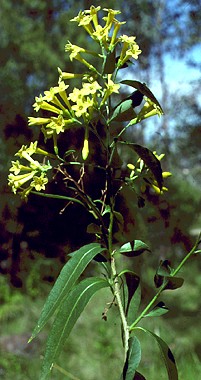
Synonymy
*Cestrum parqui L'Hér., Stirp. Nov., fasc. 4: 73; t. 36 (1788)
T: not Australian; n.v.
Description
Woody shrub to 3 m; new shoots and leaf axils minutely pubescent.
Leaves narrowly elliptic to lanceolate; lamina 20–65 mm long, usually less than 30 mm wide; petiole up to 10 mm long.
Inflorescence terminal, panicle-like, congested; flowers numerous, sessile or on pedicels to 10 mm long, occasionally subtended by short bract. Calyx 3–5 mm long; lobes triangular, 1 mm long. Corolla greenish-yellow; tube narrow, 15–18 mm long; lobes 3.5–5 mm long. Stamens inserted near middle of corolla-tube; filaments 6–7 mm long, swollen and retrorsely pubescent in lower part; anthers 0.5–1 mm long. Style 17–18 mm long.
Berry oval-ovoid, 10–15 mm long, black. Seeds prismatic, 3.5–4 mm long, dark brown.
Distribution and ecology
Originally cultivated as a garden plant, now a naturalised and common weed in south-eastern Qld, eastern N.S.W., Vic. and higher rainfall areas of S.A. There is a single herbarium collection from Scarborough in W.A. Grows in waste places in urban areas.
Common name
Green cestrum, Green poison-berry, Chilean cestrum, Willow-leaved jessamine
Notes
A declared noxious weed in Qld, N.S.W. and Vic. Toxic to cattle, horses, poultry and sheep.
Distinguished from other species by the broader corolla-tube and the black fruit.
This species has a particularly unpleasant smell when touched, Make sure you wash your hands after handling it, since it is poisonous.
Selected specimens
S.A.: Burra, D.E. Symon 8814 (ADW, CANB). Qld.: Brisbane, J. Gilleat 61 (BRI). N.S.W.: Clarence River near Lawrence, 20 Apr. 1953, J. Vickery (NSW). Vic.: Whitfield, Apr. 1940, coll. unknown (MEL).
Images and information on web
There is copious information about Cestrum parqui on the web and those mentioned represent just a selection of that which can be viewed.
Along with a number of other NSW Council sites, the Eurobadalla Shire Council site has a fact sheet and an image showing flowers, fruits and leaves. The Gwydir and Inverell Shires of NSW have further information on the plant, including its ability to poison stock, particularly cattle: see www.northwestweeds.nsw.gov.au/green_cestrum.htm
A fact sheet can be downloaded from NSW Agriculture at www.agric.nsw.gov.au/reader/weed-list/green-cestrum
The Queensland Government’s Natural Resources, Mines & Water site has a fact sheet on Green Cestrum at www.nrm.qld.gov.au/pests/weeds/non_declared_plants/green_cestrum.html and Queensland Health has images on its Poisons Information page at www.health.qld.gov.au/poisonsinformationcentre/plants_fungi/greencestrum.asp
As well as these there is further information and photographs on the Save our Waterways Now site and the Mediterranean Garden Society has a page devoted to species of Cestrum at www.mediterraneangardensociety.org/plants/Cestrum.cfm
Australian weeds sites with further downloadable information about the species can be found at Weeds Australia , Weeds CRC and Weeds in Australia
The Pacific Islands Ecosystems at Risk (PIER) page has several images of C. parqui with further links to information about the species in the Pacific.
A fact sheet on the effects of ingestion of green and orange cestrum species on animals can be downloaded from the Australian Weeds and Livestock pages dealing with the effects of plants on various farm animals.
Further information about the toxic properties of this plant can be found with a search in the FDA Poisonous Plant Database
Plant status (if any)
A declared noxious weed in N.S.W. and Vic. and prohibited in W.A.

